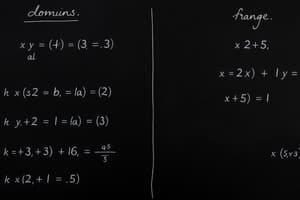Podcast
Questions and Answers
What is the domain of the function $f(x) = \sqrt{x}$?
What is the domain of the function $f(x) = \sqrt{x}$?
- All non-negative real numbers (correct)
- All integers
- All real numbers
- All positive real numbers
For the function $g(x) = \frac{1}{x-3}$, which value makes the function undefined?
For the function $g(x) = \frac{1}{x-3}$, which value makes the function undefined?
- 0
- 3 (correct)
- -3
- 1
What is the domain of the function $h(x) = \sqrt{2x - 3}$?
What is the domain of the function $h(x) = \sqrt{2x - 3}$?
- $x \leq 3/2$
- All real numbers
- $x > 0$
- $x \geq 3/2$ (correct)
If $f(x) = x + 3$ and $g(x) = \sqrt{x + 2}$, what is the domain of $g(x)$?
If $f(x) = x + 3$ and $g(x) = \sqrt{x + 2}$, what is the domain of $g(x)$?
For the function $f(x) = \frac{x}{x^2 - 4}$, which values must be excluded from the domain?
For the function $f(x) = \frac{x}{x^2 - 4}$, which values must be excluded from the domain?
What is the domain of the function $f(x) = \sqrt{x^2 + 4}$?
What is the domain of the function $f(x) = \sqrt{x^2 + 4}$?
If $f(x) = 5$ and $g(x) = x^2 - 9$, for which values does $g(x)$ yield a negative result?
If $f(x) = 5$ and $g(x) = x^2 - 9$, for which values does $g(x)$ yield a negative result?
Which of the following functions has a restricted domain due to a square root?
Which of the following functions has a restricted domain due to a square root?
Which statement best describes the domain of a function?
Which statement best describes the domain of a function?
What happens to the domain of a composite function (f ∘ g)(x) if g(x) outputs a value outside the domain of f(x)?
What happens to the domain of a composite function (f ∘ g)(x) if g(x) outputs a value outside the domain of f(x)?
In the slope formula $m = \frac{y_2 - y_1}{x_2 - x_1}$, what does 'm' represent?
In the slope formula $m = \frac{y_2 - y_1}{x_2 - x_1}$, what does 'm' represent?
Which of these functions has an undefined slope?
Which of these functions has an undefined slope?
If f(x) = x + 1 and g(x) = 1/(x - 2), which of the following statements about the composite function (f ∘ g)(x) is true?
If f(x) = x + 1 and g(x) = 1/(x - 2), which of the following statements about the composite function (f ∘ g)(x) is true?
Flashcards
Domain of a function
Domain of a function
The set of all possible input values (x-values) for which a function is defined.
√(x-a)
√(x-a)
The domain of the square root function (√x) is all x-values such that the term inside of the square root is greater than or equal to zero (≥0).
√(2x-3)
√(2x-3)
The domain of the given function is x ≥ 3/2 (1.5).
f(x) + g(x)
f(x) + g(x)
Signup and view all the flashcards
f(x)-g(x)
f(x)-g(x)
Signup and view all the flashcards
f(g(x))
f(g(x))
Signup and view all the flashcards
f(g(x)) when x = n
f(g(x)) when x = n
Signup and view all the flashcards
f(g(1))
f(g(1))
Signup and view all the flashcards
Domain of a Function
Domain of a Function
Signup and view all the flashcards
Composite Function
Composite Function
Signup and view all the flashcards
Slope of a Line
Slope of a Line
Signup and view all the flashcards
Slope Formula
Slope Formula
Signup and view all the flashcards
Undefined Slope
Undefined Slope
Signup and view all the flashcards
Study Notes
Domain of Functions
- Finding the domain: Determine the set of all possible input values (x-values) for a function.
Problem 1
- Function: f(x) = (x + 3)² / (x² − 3)
- Domain: All real numbers except x = ±√3 (where the denominator is zero)
Problem 2
- Function: f(x) = √(8 - x) / (x - 10)
- Domain: x ≤ 8 and x ≠ 10
Problem 3
- Function: f(x) = √(x + 3) / (x + 4)
- Domain: x ≥ -3 and x ≠ -4
Problem 4
- Function: f(x) = √(2x - 3)
- Domain: x ≥ 3/2
Problem 5
- Function: f(x) = x² - 2x - 3
- Domain: All real numbers (since it's a quadratic without restrictions)
Problem 6 and 7
- Composition of functions f(x) = x - 3, g(x) = √(x + 1)
- f + g(x): (x - 3) + √(x + 1)
- f - g(x): (x - 3) - √(x + 1)
- Domain restrictions: x ≥ -1 for g(x)
- f + g(x) Domain: x ≥ -1
- f - g(x) Domain: x ≥ -1
Problem 8
- Composition of functions.
- f + g(x): x - 3 + √(x + 1)
- f - g(x): x - 3 - √(x + 1)
- Domain restrictions: x ≥ -1 for all compositions
Problem 9
- f(x) = x - 3, g(x) = √(x + 1)
- f(x) + g(x): x − 3 + √(x + 1)
- Domain: x ≥ -1 for √(x + 1)
Problem 10
- f(16): Given f(x) = x - 3, g(x) = √(x + 1)
- f + g(16): 16 − 3 + √(16 + 1) = 13 + √17
- Domain: x ≥ -1, so f(x) and g(x) are defined
Problem 11 and 12 and 13
- Function compositions: Calculate g(f(x)) by substituting f(x) into g(x), g(f(12)), and finding f – g(-2) and fg(1). Details are included in given data.
Problem 14
- Function composition: f(x) = x + 3, g(x) = √(x + 2)
- f ◦ g(x): f(√(x + 2)) = √(x + 2) + 3
- Domain: x ≥ -2
Problem 15
- Function composition: f(x) = x + 3, g(x) = √(x + 2)
- g ◦ f(x): g(x + 3) = √(x + 3 + 2) = √(x + 5)
- Domain: x ≥ -5
Studying That Suits You
Use AI to generate personalized quizzes and flashcards to suit your learning preferences.




